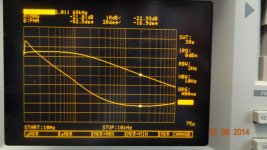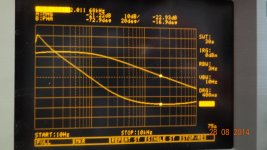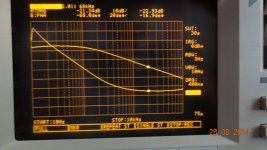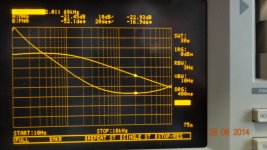Here are the symptoms and they can be cured by carefull design :http://www.klippel.de/uploads/media/Klippel_Nonlinearity_Poster.pdf
Modern drivers do not benefit as much from current drive as some may think.
The current drive erodes basically dynamic unlinearities in the impedance curve.
When BL is symmetrical, so is the suspension and the voice coil is fully compensated with a copper cap there is not much benefit left.
Crappy drivers benefit a lot though.
Which would be cheaper way to lower distortion from the driver? An amp designed for current drive for crappy speakers or a much better driver?
How much would current drive lower distortion of even the best drivers?
THx-RNMarsh
Which would be cheaper way to lower distortion from the driver? An amp designed for current drive for crappy speakers or a much better driver?
How much would current drive lower distortion of even the best drivers?
THx-RNMarsh
Very pertinent questions.
Actually, I'm rather surprsed by Joachim's statements, given that the Germans are traditionally, from the days even before DIN 45500, obssessed with 4 Ohm impedances, and then demanded that their amps be able to drive two paralleled pairs of speakers.
This in effect built-in low impedance drive capability is what used to make their nominally low powered amps produce a much fuller and authoritative sound than most Japanese amps which nominally had several times their power output - but into pure 8 Ohms only.
My answer to Richard's questions would that low impedance drive capability is now perhaps even more important than before, since we are now flooded by junk products, mostly from the Far East, which are often anything but 8 Ohms.
If perhaps not structly speakin a must, still this eanbles the one thing I have always loved about most serious US designed amps, that wonderful feeling of ease of drive, that complete absence of effort on the side of the amp. Make no mistake, that is a very elusive effect.
Back to C and esr vs temp affects ---
I did a quick test this morning using bipolar cap used for speaker cross overs (a new cap) -- at difference ambient cap temps..... 77 degrees F, 87F and 97F. Note the phase response changes:
 base line
base line


Phase change with this cap is -- about 15 degrees.
Does that matter to a cross-over filter? I think so.
This is just one cap illustration.... other values give larger changes. So, this is not worse case. "Your milage may vary".
I already showed large phase changes with just a few inches of wire between cap and its load.
With this particular cap, 12 inch of wire added to cap changes the phase at 2KHz from 82.5 degrees to 52 degrees. About a 30 degree phase change!

BTW-- its the esr that keeps the cap from being 90 degrees. Its the esr that is changing the most with temp as the magnitude of the Z didnt change.
yes, you can go to active crossover and seperate amps.....
what about placing each filter at the driver instead of one pcb at the bottom of a cabinet and long wires to each driver? Thats what I've done and the results are a lot closer to the SIM afterwards.
THx-RNMarsh
I did a quick test this morning using bipolar cap used for speaker cross overs (a new cap) -- at difference ambient cap temps..... 77 degrees F, 87F and 97F. Note the phase response changes:
 base line
base line

Phase change with this cap is -- about 15 degrees.
Does that matter to a cross-over filter? I think so.
This is just one cap illustration.... other values give larger changes. So, this is not worse case. "Your milage may vary".
I already showed large phase changes with just a few inches of wire between cap and its load.
With this particular cap, 12 inch of wire added to cap changes the phase at 2KHz from 82.5 degrees to 52 degrees. About a 30 degree phase change!

BTW-- its the esr that keeps the cap from being 90 degrees. Its the esr that is changing the most with temp as the magnitude of the Z didnt change.
yes, you can go to active crossover and seperate amps.....
what about placing each filter at the driver instead of one pcb at the bottom of a cabinet and long wires to each driver? Thats what I've done and the results are a lot closer to the SIM afterwards.
THx-RNMarsh
Last edited:
Here you see some honest measurements :www.audioexcite.com SB Acoustics “Satori” MW16P-4
This is with voltage drive of cause.
Most distortion in modern drivers ( in the midrange ) come from slight mechanical missmatch of the cone and suspension.
You see that in the micro structure of the impedance curve.
Current drive does not help here.
This is with voltage drive of cause.
Most distortion in modern drivers ( in the midrange ) come from slight mechanical missmatch of the cone and suspension.
You see that in the micro structure of the impedance curve.
Current drive does not help here.
10 years ago i whould have said that current drive helps most in the bass.
Look at this animal though :http://www.scan-speak.dk/datasheet/reviews/32W-4878T00-KlangTon_2013-2.pdf
Even at high level and 20Hz distortion is under 1%.
OK; this driver is not pocket change.
Look at this animal though :http://www.scan-speak.dk/datasheet/reviews/32W-4878T00-KlangTon_2013-2.pdf
Even at high level and 20Hz distortion is under 1%.
OK; this driver is not pocket change.
Thanks Joachim.
Richard you do need to be careful when placing a x-over next to an unshielded speaker magnet, I think you understand what would happen to the inductor values next to a strong magnetic field.
_______
Of course...... and, there are magnetically shielded drivers.
_____
if the main cause of distortion (midrange) is the cone/suspension interface mismatch..... do you mean that is what differentiates a good from a crappy driver? If So, how much is material choices and how much is QC?
-RM
Last edited:
A lot has been pubished by driver mfr of high power speakers on compression and distortion.
Have you read the book..... "Current-Driving of Loudspeakers" by Esa merilainen
"Eliminating Major Distortion and Interfrence effects by the Physically Correct Operation Method".
first edition 2010.
?
THx-RNMarsh
Thanks Richard, I wasn't aware of this book.
It's actually long known that current drive can work to reduce distortion in loudspeakers. Mills and Hawksford published an AES paper on it in 1989. I also think there was something in it in the first Linear Audio.
Dunno if Esa Merilainen has something to add to this, if anybody can recommend it, I will order a copy, or might do so for the heck anyways.
The problem with current drive may not so much that it not has been generally acknowledged as being better, but rather that it is not so easy to implement. As I mentioned before, it will be necessary to include a compensation for the impedance peak(s) of the bass driver. I gather not just to have a flat FR, but also to correct phase. I would expect some stability related complications because of current being out of phase with voltage, but I am not an amplifier designer.
This means that there can not be a general current drive amplifier; the only correct one would have to be loudspeaker specific. So here is the challenge. Which amplifier designer will team up with which loudspeaker designer to get this off the ground? I think great progress can still be made in the field of amplifier development, but there has to be a new focuss.
B.t.w., partial current drive brings partial advantages, so putting a resistor in front of a driver is a good idea even in an active speaker for the drivers that do not take too much current. This is a good thing of analog xovers (the only good thing), because they typically force the designer to attenuate the mid and the high by placing a resistor in series with the driver.
Industry is a good source. JBL/Harman allowed a lot of their top engineers to write on a large number of loudspeaker related technical issues. For those interested, this is the overview: Harman - Scientific Publications. Phillips when they still did speakers also allowed their people to publish on research, in the pre-internet era.
Thanks Joachim.
Richard you do need to be careful when placing a x-over next to an unshielded speaker magnet, I think you understand what would happen to the inductor values next to a strong magnetic field.
Methinks it is not so much the magnetic field that changes the inductor value, but the ferromagnetic and or ferrimagnetic material in close proximity to air core coils that does so. This increases the inductance.
The reason is that an air core coil cannot saturate, so the magnetic field of a loudspeaker does not influence its capacity to store electric energy in the form of an added or substracted magnetic field.
When the magnetic field of the Earth flips, at least we will not have to worry about our xovers going out of alignment.
10 years ago i whould have said that current drive helps most in the bass.
Look at this animal though :http://www.scan-speak.dk/datasheet/reviews/32W-4878T00-KlangTon_2013-2.pdf
Even at high level and 20Hz distortion is under 1%.
OK; this driver is not pocket change.
Very nice. I have a pair of TC Sounds model LMS Ultra 5400 subs still in the box (es). If the Scan-Speaker has lower distortion, I'll sell these and get those. Do you have any data on the TC Sounds?
THx-RNMarsh
Merilainen uses relatively simple drivers and rather primitive amps.
In that context he got an improvement but what has that to do with the state of the art ?
There are other ways to lower distortion in the bass.
One is push-pull that reduces second harmonic by 10dB ( x 3 ) i measured.
Commercially it is anyway moot.
Nelson Pass did some interesting work with wideband drivers.
That makes some sense to me but you end up with a " one off ".
We made a servo sub 20years ago that had a bridge and partial current drive.
Full current drive gave problems with thermal runnaway.
In that context he got an improvement but what has that to do with the state of the art ?
There are other ways to lower distortion in the bass.
One is push-pull that reduces second harmonic by 10dB ( x 3 ) i measured.
Commercially it is anyway moot.
Nelson Pass did some interesting work with wideband drivers.
That makes some sense to me but you end up with a " one off ".
We made a servo sub 20years ago that had a bridge and partial current drive.
Full current drive gave problems with thermal runnaway.
I talked to the people from TC Sounds on ocations. They are original from Germany.
Those drivers look awesome too but i have no personal experience.
Using a big cone with long throw also helps to get the distortion under control.
Some people do not have the space though.
Those drivers look awesome too but i have no personal experience.
Using a big cone with long throw also helps to get the distortion under control.
Some people do not have the space though.
Current mode drive of speakers
Richard,
I have the book, and the author is smart and I agree with a lot of what he supposes, and have not critiqued his math. I was in conversation with him via email up to the point where the lab I was employed at closed in 2013.
I designed a current-mode amp/speaker combination in the early 1990s, and spent a lot of time modeling the freq/phase relationship of the speaker and implementing it in the current drive circuit. The audible difference was very pronounced compared to the voltage drive versions of the same amp/speaker. Much tighter drum attacks, of course demanding more of the amp at the same time. The tonal balance of the system was different, which some might say should not be the case if I modeled the speaker correctly, but the differences we heard were hard to quantify.
A summary of the sound would be: more present, the speakers seemed to project more and it was exciting to hear. I feel stupid using subjective terms, because I had tweaked the system to give flat response, so I am fairly certain there was minimal freq domain errors. The biggest difference I can relate to you: using a B&K 3004 mic I was able to recover a very nice looking 1KHz square wave from the system in current drive, which it was unable to do in voltage drive, thanks to phase shifts between the harmonics.
I was a big proponent of the approach, and shopped the design around. I ended up demoing with non-disclosures for several mobile sound companies, one of which then copied the circuit and went on to make a metric s#!t-ton of $$ with it. My lawyer's cease and desist went unanswered and I was too non-munificent to pursue. A lesson in IP protection....
I still think it is the best sounding approach to dynamic loudspeaker drive, but to be optimally implemented requires a different speaker driver design (low Z, low Q), and of course a different amp design. Its a BIG project I no longer have the resources for.
Such is life...
Howie
Howard Hoyt
CE - WXYC-FM 89.3
UNC Chapel Hill, NC
www.wxyc.org
Have you read the book..... "Current-Driving of Loudspeakers" by Esa merilainen
"Eliminating Major Distortion and Interfrence effects by the Physically Correct Operation Method".
first edition 2010. ?
THx-RNMarsh
Richard,
I have the book, and the author is smart and I agree with a lot of what he supposes, and have not critiqued his math. I was in conversation with him via email up to the point where the lab I was employed at closed in 2013.
I designed a current-mode amp/speaker combination in the early 1990s, and spent a lot of time modeling the freq/phase relationship of the speaker and implementing it in the current drive circuit. The audible difference was very pronounced compared to the voltage drive versions of the same amp/speaker. Much tighter drum attacks, of course demanding more of the amp at the same time. The tonal balance of the system was different, which some might say should not be the case if I modeled the speaker correctly, but the differences we heard were hard to quantify.
A summary of the sound would be: more present, the speakers seemed to project more and it was exciting to hear. I feel stupid using subjective terms, because I had tweaked the system to give flat response, so I am fairly certain there was minimal freq domain errors. The biggest difference I can relate to you: using a B&K 3004 mic I was able to recover a very nice looking 1KHz square wave from the system in current drive, which it was unable to do in voltage drive, thanks to phase shifts between the harmonics.
I was a big proponent of the approach, and shopped the design around. I ended up demoing with non-disclosures for several mobile sound companies, one of which then copied the circuit and went on to make a metric s#!t-ton of $$ with it. My lawyer's cease and desist went unanswered and I was too non-munificent to pursue. A lesson in IP protection....
I still think it is the best sounding approach to dynamic loudspeaker drive, but to be optimally implemented requires a different speaker driver design (low Z, low Q), and of course a different amp design. Its a BIG project I no longer have the resources for.
Such is life...
Howie
Howard Hoyt
CE - WXYC-FM 89.3
UNC Chapel Hill, NC
www.wxyc.org
- Status
- Not open for further replies.
- Home
- Member Areas
- The Lounge
- John Curl's Blowtorch preamplifier part II